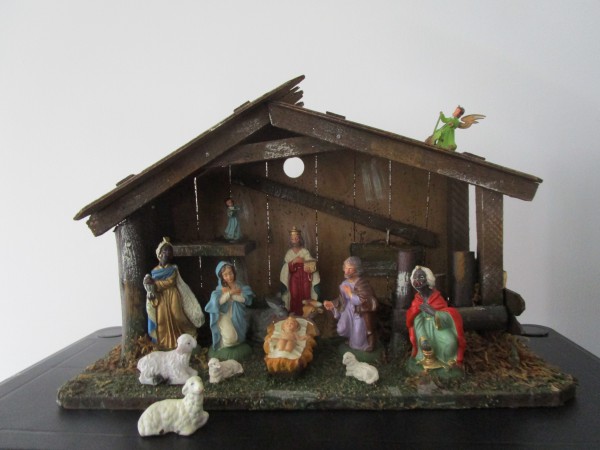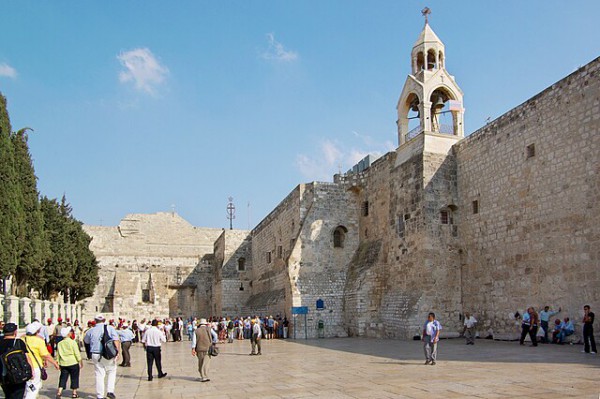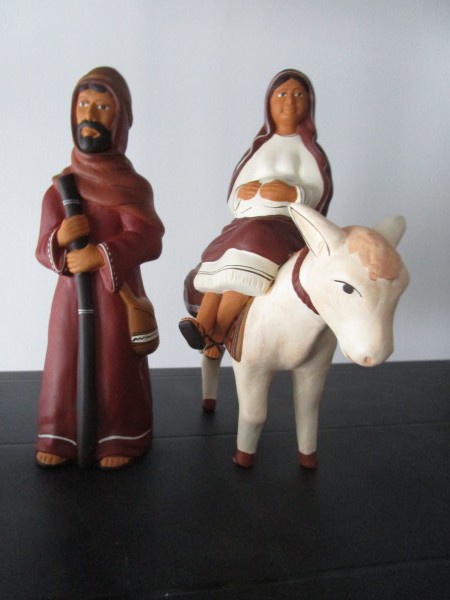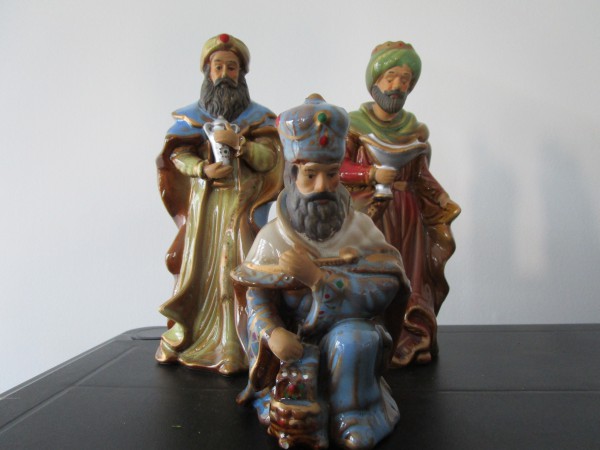Places and Characters
Most nativity scenes contain the same basic elements, although they may be adapted according to the culture or the creators’ intent. They are Jesus, Mary and Joseph, a manger (or a crib) in a barn or a cave, the shepherds, the Wise Men, an ox and a donkey, and sometimes a star and angels.
On This Page
Places
Characters
To Learn More
Places
According to Christian tradition, the birth occured in Bethlehem, about 10 kilometers south of Jerusalem.
The Manger
Neither Luke or Matthew mention the exact location of Jesus’ birth. Luke wrote that Mary swaddled Jesus and put him in a manger. Hay was used to keep the newborn warm.
A Cave or a Barn?
According to an apocryphal story, James’ Gospel, Mary gave birth to Jesus in a cave near Bethlehem. Three days later, Jesus and Mary moved to a barn.
Shepherds used caves in the hills near Bethlehem to shelter themselves and the animals on colder nights. Since the 4th century, a Christian Basilica stands on the presumed location of Jesus’ birth.
In nativity scenes from the eastern church traditions, the birth takes place in a cave. This is also the case in some Italian nativities. Elsewhere in Europe, a barn replaces the cave, and this version is used most often.
The Star
The Gospel according to Matthews mentions a star that would have guided the Wise Men to Bethlehem. Since the 16th century, scientists have searched for an astronomical phenomenum around the time of Jesus’ birth that would be ”the star”. Various hypothesis have been offered, such as a planetary conjunction or a comet.
TOP
characters
Jesus
Jesus, in a manger, is the nativity scene’s character.
In the Gospel according to Matthew, Mary put Jesus in swaddling clothes. From the Renaissance, Jesus was shown wearing a simple piece of clothe, or even naked and surrounded by a radiating light. This came from the visions of a 14th century mystic, Bridget of Sweden. Both traditions are still seen today.
Mary
Of course, Mary, Jesus’ mother, has an integral place in the nativity scene. Surprisingly, it is only from the 5th century that she appears constantly in depictions of the nativity.
Until the end of the Middle Ages, Marie was usually shown lying down, resting after labour. Today’s Mary is shown kneeling in prayer. This dates back to Bridget of Sweden.
Joseph
Joseph, Jesus’ foster father, is usually shown as an old man. This representation, and the staff he holds, are from James’ Gospel. In Bridget of Sweden’s visions, Joseph holds a candle; it became the lamp he holds in many nativity scenes.
The Angels
In the Gospel according to Luke, an angel appears to shepherds near Bethlehem to announce Jesus’ birth. A ”great throng of the hosts of heavens” joins the angel and praises God.
The Shepherds
Shepherds near Bethlehem are the first people to learn of Jesus’ birth. In the Gospel according to Luke, they visit the newborn and his mother, responding to the angel’s message. In some nativity scenes, they are kneeling and worshiping Jesus, something not mentioned in the Gospel. There are often sheep with them.
The Wise Men
In the Gospel according to Matthew, wise men from the East come to worship the child Jesus and give him three gifts : gold, frankinsense and myrrh. They are often referred to as magi. Depending on the source, this word refers to an astrologer, a magician, a disciple of Zoroaster or a member of the priestly class in some ancient Middleeastern societies. The Gospel doesn’t give their number or names.
The magi who came to worship Jesus become kings at the end of the second century This was in refrence to Psalm 92, in which kings come to pay hommage to the Messiah and bring him presents.
The number of wise men varied during Christiannity’s first centuries – up to 12 ! Three became the standard number, matching the number of gifts. Their traditional names, Caspar, Melchior, Balthazar, appeared in the 8th century. A late 7th-century English monk, Bede the Venerable, gave their places of origin as the three continents known to Europeans at the time : Africa, Asia and Europe. Balthazar, the ”Black-skinned king”, became such in the 14th century; this became his standard representation in the 16th century.,
The Wise Men are often with camels, a commonly used mode of transportation in the ancient Middle East.
Between the Ox and the Grey Donkey
The Gospels do not mention these two animals. Hoiwever, they appear in the earliest visual representations of Jesus’s birth,, even earlier than Mary and Joseph. The appeared in a 7th century apocrypha, the Gospel of Pseudo-Matthew. Mary likely travelled to Bethlehem on a donkey.
TOP
To Learn More
The Glencairn Museum (Pennsylvania) Website includes a very good presentation of the sources and the main characters in the Nativity story. To know more about Bridget of Sweden, see her Wikipedia entry.
TOP




